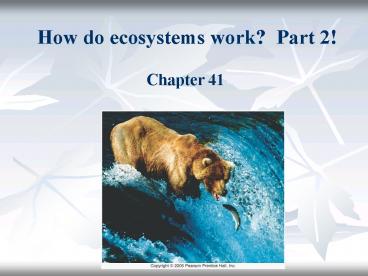How do ecosystems work Part 2 - PowerPoint PPT Presentation
1 / 17
Title:
How do ecosystems work Part 2
Description:
Chinstrap penguin (Photo: Shir Goldberg. Shift in penguin species on the Antarctic Peninsula ... Nitrogen cycle (review) Phosphorous cycle (preview) ... – PowerPoint PPT presentation
Number of Views:17
Avg rating:3.0/5.0
Title: How do ecosystems work Part 2
1
How do ecosystems work? Part 2!
Chapter 41
2
How does increased CO2 cause global warming?
- Greenhouse effect
- Certain gases in the atmosphere (water vapor,
methane, CO2 ) absorb heat. - More greenhouse gases ? more trapped heat
- Earth does need some greenhouse gases!
- Without any heat-absorbing molecules, the earth
would be too cold for life! - But we are now overheating the earth
3
Some potential impacts of global warming
- Melting of ice ? sea level rise
- Some low-lying islands have already been
inundated - Changes in weather patterns
- Droughts in some places, floods in others
- Shift in agricultural centers (loss of some, gain
of others) - Increased hurricane intensity
- Shifts in species distribution
- Example 1 Mosquitoes that carry Plasmodium (the
malaria parasite) - How have they shifted? (Think about logically,
considering they are found in warm climates) - Example 2 Penguins in the Antarctic
4
Focus Antarctic penguins
Gentoo penguins (Photo B. Grunewald)
Chinstrap penguin (Photo Shir Goldberg
Adelie penguins (Photo K. Haberman)
5
Shift in penguin species on the Antarctic
Peninsula
6
What can you do???
- Overall, reduce use of fossil fuels.
- Buy energy efficient appliances.
- Line dry your clothes.
- BUY LOCALLY!
- Shipping of products around the world uses a
great deal of fossil fuels. - Buy certified organic food (minimal use of
fertilizers that use fossil fuels to make.) - Invest in alternative, renewable energy.
- Vote wisely
7
Nitrogen cycle (preview)
8
Nitrogen cycle Nitrogen fixation
- The atmosphere is earths major nitrogen
reservoir - N2 gas not directly usable by producers
- Nitrogen fixation converts N2 to usable nitrogen
forms (ammonia and nitrate) - Lightning fixes nitrogen
- Bacteria fix nitrogen
- Humans fix nitrogen via chemical processing to
make fertilizers or by burning fossil fuels.
9
Nitrogen cycle Cycling through food webs
- Primary producers take up ammonia and nitrate
- Convert to organic nitrogen (part of protein
DNA molecules) - Consumers feed on producers
- Gain organic molecules with nitrogen
- Bacteria decompose dead organisms
- Convert back into inorganic forms that can be
taken up by producers
10
Nitrogen cycle Denitrification
- Denitrifying bacteria convert nitrates and
ammonia back into atmospheric nitrogen
11
Nitrogen cycle (review)
12
Phosphorous cycle (preview)
13
Phosphorous cycle How does phosphorous enter
ecosystems?
- Phosphorous comes from rocks (reservoir for
phosphorous) - Weathering of rocks and runoff moves phosphorous
into ecosystems - Human-synthesized phosphorous (as phosphates) are
also applied to crops
14
Phosphorous cycle Cycling through food webs
- Primary producers take up phosphorous
- Convert inorganic phosphates to organic
phosphorous (part of protein, lipid DNA
molecules) - Consumers feed on producers (arrow missing in
diagram!) - Gain organic molecules with phosphorous
- Bacteria decompose dead organisms
- Convert back into inorganic forms that can be
taken up by producers
15
Phosphorous cycle Loss of phosphorous from
ecosystems
- Phosphorous ends up in aquatic sediments (such as
deep ocean) - Will only be reintroduced with uplifting of
mountains!
16
Phosphorous cycle (review)
17
Phosphorous and aquatic ecosystems
- Agricultural and domestic runoff puts excessive
amounts of phosphorous into aquatic ecosystems - Intense blooms of phytoplankton
- Often these are toxic species Why?
- Dead zones Too much phytoplankton at once ? All
dies at once? bacterial decomposition of excess
phytoplankton reduces oxygen ? animals die - Clean Water Act (1977)
- Reduction of phosphate-based detergents has
decreased this problem in some places





























